For the past three years, rapid testing of Shiga toxin-producing Escherichia coli (STEC), one of the causes of foodborne illnesses, has been one focus of the Coordinated Agricultural Program (CAP) grant from the U.S. Department of Agriculture (USDA). CAP grant researchers specially are developing and testing detection methods for the several STEC pathogens, including O26, O45, O103, O104, O111, O121, O145 and O157, in the beef industry.
One such DNA-based detection method is multiplex oligonucleotide ligation-PCR (MOL-PCR), of which CAP grant researchers Travis Wood, a graduate student at the University of New Mexico, and his advisor, Alina Deshpande, a scientist at Los Alamos National Laboratory, led the development and validation. The assay is now in the process of independent testing by another CAP grant researcher.
MOL-PCR can rapidly screen samples concurrently for several STEC O serogroups and three major virulence factors (genes for two Shiga toxin and intimin). According to the USDA Food Safety and Inspection Service (FSIS), to be classified as an adulterant, an isolate would have to be positive for one of the targeted O serogroups as well as a Shiga toxin and intimin.
The MOL-PCR STEC assay that has been developed is a screening test, and CAP grant researchers have developed it to run on DNA from culture. Beginning with the culture material, MOL-PCR produces results in the same day. Beginning with a ground beef sample, results are possible in two days.
Besides independent lab testing of the MOL-PCR screening test, CAP grant researchers are working on a MOL-PCR characterization assay. This assay detects the seven non-O157 STEC that are adulterants, but it is looking at a different gene than the first MOL-PCR. In essence, the characterization assay is testing for individual genes representing each of the seven types of adulterants that would be further confirmation that particular sample has the adulterant in it, explains Rod Moxley, a professor at the School of Veterinary Medicine and Biomedical Sciences at the University of Nebraska-Lincoln and project director of the CAP grant. CAP grant researchers are looking at a variation of one gene, called a single nucleotide polymorphism (SNP). One individual nucleic acid substitution in that gene makes it unique, and the types of E. coli that are adulterants would have that kind of substitution.
“It’s targeting a sequence that’s very typical for a particular, let’s say O1O3, O111 or O26, but it would be a second type of MOL-PCR assay that would be called a characterization assay,” Moxley explains. “We could do it on that same sample that’s been screened, and then come up with more additional confirmatory evidence that the adulterant is there.”
While several PCR assays that can search for multiple genes at a time exist, MOL-PCR is rapid and high throughput, translating to a lot more samples being run through, in comparison to end-point PCR and quantitative real-time PCR (qPCR). MOL-PCR also is relatively inexpensive. In addition, while MOL-PCR has been developed to test for 11 markers, it is adaptable and can potentially go up to 50 at a time.
“What that means is that you can get a tremendous amount of information about a sample because you are looking at many, many different targets at once,” Moxley explains. “The more evidence you have, the greater the likelihood of something being positive. You also can easily add more genetic markers to this assay that you already developed. Instead of starting all over again, you can add things into the mix, which is a big advantage.”
Outside of the CAP grant research, another rapid technology researchers are studying involves droplet digital PCR (ddPCR). Like qPCR, this method allows for quantification of STEC target genes; however, its researchers say ddPCR has a couple of advantages. First, ddPCR yields accurate absolute quantification without the need to rely on a standard curve. This is important because the construction of a standard curve requires accurately quantified template DNA, which might be difficult to obtain. Second, ddPCR is less prone to inhibitors of DNA polymerase, e.g., bile salts, than qPCR.
Detecting biomarkers
CAP grant researchers also have been working to address the USDA request for development of biosensors, which in essence would detect biological phenomenon. For example, this could be a binding of part of a pathogen to a surface or to a receptor that would normally be present on a cell or body.
“The way pathogens infect you is by binding to something that allows them to get a foothold on the surface and then establish a connection that allows them to grow,” Moxley says.
In turn, the CAP grant is using a waveguide-based optical biosensor, with development led by Loreen Stromberg, currently a postdoctoral research associate at Iowa State University, and her advisor, Harshini Mukundan, a scientist at the Los Alamos National Laboratory, to detect the binding of a key surface molecule, lipopolysaccharide, which is the outer part of the membrane of the E. coli. CAP grant researchers use antibodies to detect the lipopolysaccharide in a very sensitive method that eliminates a lot of background.
“It works by detecting key molecules in a pathogen by an ability to bind to the surface,” Moxley explains. “Then antibodies are used that are specific for that molecule that have a fluorescent label on them, and that florescent light can be detected. Then another key part of the way this system works is that light fades out a short distance above the surface where the pathogen is bound. The further you get, and we are talking in an extremely minute space here above the membrane, that light completely disappears. That really eliminates a lot of artificial signal, which is important in the system.”
This waveguide biosensor assay is very different from the MOL-PCR or any of the DNA-based methods. “This is detecting an actual part of the bacteria, an outer membrane, as opposed to its DNA,” Moxley says. “There aren’t many places around the country that are developing methods for detecting non-DNA targets.” NP






Report Abusive Comment